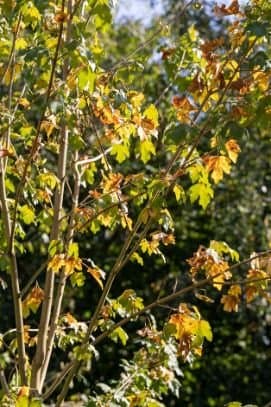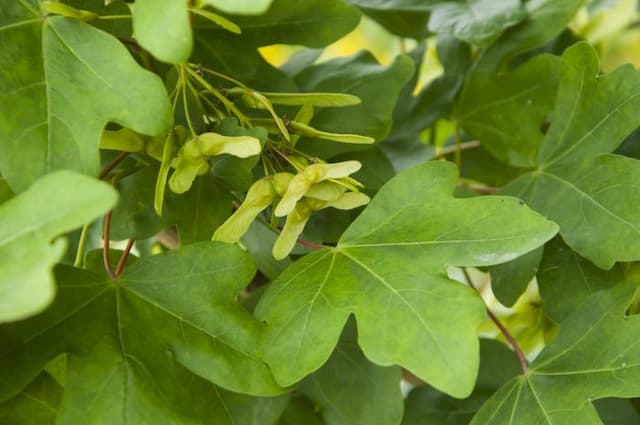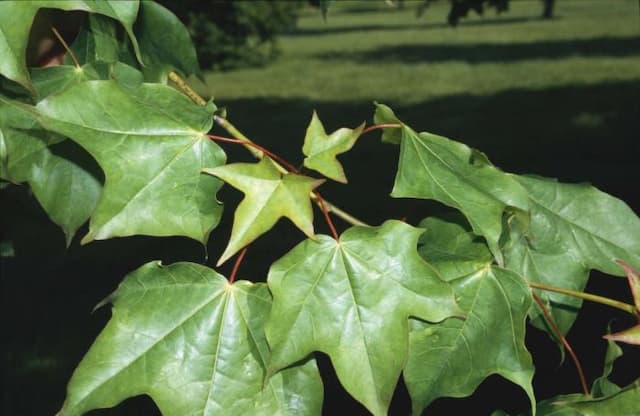Yellowhorn Xanthoceras sorbifolium

ABOUT
Commonly known as yellowhorn, Xanthoceras sorbifolium is a flowering plant that boasts distinctive features with prominent floral and foliar displays. Its leaves are arranged in a compound manner, with multiple leaflets spreading out from a single point, somewhat similar to the appearance of a hand with spread fingers. These leaflets are narrow, giving the leaves a feathery look, typically bright green and offering a lush aesthetic to the plant. The most striking characteristic of yellowhorn is its flowers. They bloom in luxurious clusters at the ends of the branches, with each flower showing off multiple petals that are usually white with a conspicuous red or yellow base, providing a stunning contrast against the green foliage. These blossoms not only add ornamental value but also attract various pollinators to the garden. Once flowering ceases, the plant produces interesting fruits that start appearing as green and mature to a darker shade. These fruits are in a capsule-like form and contain seeds that can be utilized for various purposes. The overall appearance of yellowhorn, with its compound leaves and showy flowers, makes it an attractive choice for ornamental planting and a striking addition to any landscape where it can be accommodated.
About this plant
 Names
NamesFamily
Sapindaceae
Synonyms
Yellowhorn, Shiny Leaf Yellowhorn, Goldenhorn, Chinese Flowering Chestnut
Common names
Xanthoceras sorbifolium Bunge, Strahlenia sorbifolia (Bunge) Regel.
 Toxicity
ToxicityTo humans
Yellowhorn is not typically known for its toxicity to humans. However, as with many plants, it may cause mild stomach upset if ingested in large quantities or if an individual has a particular sensitivity to it. There are no well-documented cases of poisoning by consuming yellowhorn, so it is generally considered safe. It is, however, always wise to exercise caution and avoid eating any plant parts unless they are known to be safe and edible.
To pets
Yellowhorn is not commonly recognized as a toxic plant to pets. While it does not have a reputation for being poisonous, as with many plants, its ingestion in significant quantities might cause mild gastrointestinal distress in certain pets due to their specific dietary sensitivities. Since there is no widespread evidence of the plant causing severe toxicity, it is likely relatively safe for pets. Nevertheless, as pets may have varying reactions to different plants, it is prudent to prevent pets from ingesting plants that are not confirmed to be safe for them.
 Characteristics
CharacteristicsLife cycle
Perennials
Foliage type
Deciduous
Color of leaves
Green
Flower color
White
Height
8-15 feet (2.4-4.6 meters)
Spread
8-12 feet (2.4-3.7 meters)
Plant type
Tree
Hardiness zones
4-7
Native area
China
Benefits
 General Benefits
General Benefits- Ornamental Value: Xanthoceras sorbifolium, commonly known as Yellowhorn, features showy white flowers with yellow or red centers that bloom in spring, adding aesthetic appeal to gardens and landscapes.
- Drought Tolerance: Once established, Yellowhorn is quite drought-tolerant, making it suitable for xeriscaped gardens and areas with low water availability.
- Wildlife Habitat: The flowers provide nectar for pollinators, while the seeds are a food source for birds, enhancing biodiversity.
- Edible Seeds: The seeds of Yellowhorn are edible and can be consumed by humans, often used in traditional cuisines or as a snack.
- Cold Resistance: Yellowhorn can tolerate cold temperatures, allowing it to thrive in cooler climates where other flowering plants may struggle.
- Low Maintenance: Once established, Yellowhorn requires minimal care, making it a convenient choice for gardeners of all skill levels.
 Medical Properties
Medical Properties- Anti-inflammatory: Xanthoceras sorbifolium extracts have been reported to possess anti-inflammatory properties, which could help reduce inflammation in certain conditions.
- Antioxidant: The plant contains compounds with antioxidant effects that can neutralize free radicals and may contribute to preventing cellular damage.
- Antitumor: Some studies suggest that certain compounds in Xanthoceras sorbifolium may have antitumor activity, potentially inhibiting the growth of cancer cells.
- Cardioprotective: There is evidence that suggests the plant may have cardioprotective effects, which could help protect heart tissue from damage.
- Hepatoprotective: Compounds in Xanthoceras sorbifolium might offer protective effects to the liver, possibly helping to prevent liver damage from toxic substances.
- Neuroprotective: Some research indicates that Xanthoceras sorbifolium could have neuroprotective effects, potentially aiding in the protection of nerve cells.
 Air-purifying Qualities
Air-purifying QualitiesThis plant is not specifically known for air purifying qualities.
 Other Uses
Other Uses- Xanthoceras sorbifolium, commonly known as yellowhorn, can be utilized in landscape design for its attractive spring blooms that add aesthetic value to parks and gardens.
- The seeds of yellowhorn have a high oil content and can be pressed for biofuel production as a renewable energy source.
- Yellowhorn wood is dense and could potentially be used for crafting small wooden objects or as a source of specialty lumber.
- The plant's resilience allows it to be used in soil erosion control projects, especially in areas with poor soil conditions.
- Yellowhorn flowers are rich in nectar and can attract pollinators such as bees, thus aiding in the pollination of crops and maintaining biodiversity.
- Its leaves can serve as a fodder for some livestock, particularly goats, providing them with a source of forage in pastures.
- Yellowhorn's ornamental seedpods can be used in dried flower arrangements and decorative purposes once the seeds have been harvested.
- The decorticated seeds, which are edible, can be used as a coffee substitute or incorporated into various culinary dishes.
- Its ability to grow in a variety of soil types, including poor soils, makes yellowhorn a candidate for reclaiming disturbed lands such as mined areas.
- Yellowhorn is sometimes used in the study of genetic diversity and plant breeding due to its unique genetic attributes.
Interesting Facts
 Feng Shui
Feng ShuiThe Yellowhorn is not used in Feng Shui practice.
 Zodiac Sign Compitability
Zodiac Sign CompitabilityThe Yellowhorn is not used in astrology practice.
 Plant Symbolism
Plant Symbolism- Renewal: Xanthoceras sorbifolium, also known as yellowhorn, typically blooms in spring, symbolizing new beginnings and the cycle of life.
- Rarity and Uniqueness: As a lesser-known ornamental plant, yellowhorn signifies individuality and the value of rare traits.
- Strength: The hardiness of yellowhorn, capable of thriving in diverse conditions, can represent personal resilience and adaptability.
- Youthful Energy: The vibrant flowers and rapid growth rate of yellowhorn evoke the vivacity and exuberance associated with youth.
 Water
WaterThe Yellowhorn should be watered deeply and slow-timed to encourage a deep root system. During the first growing season, it is essential to maintain evenly moist soil, which may require watering weekly with approximately 1 to 1.5 gallons per event. Once established, the Yellowhorn is drought-resistant and will require less frequent waterings, possibly every two to three weeks, depending on the climate and soil conditions. It's important not to overwater, as this can lead to root rot.
 Light
LightThe Yellowhorn thrives in full sun to part shade conditions. The ideal spot for the plant is a location where it can receive at least six hours of direct sunlight daily. However, in areas with intense summer heat, some afternoon shade can be beneficial to prevent scorching.
 Temperature
TemperatureYellowhorn is a hardy plant that can withstand temperatures as low as 20 degrees Fahrenheit but will thrive best in temperatures ranging from 60 to 85 degrees Fahrenheit. Although it can tolerate brief periods of colder winter temperatures, prolonged exposure to temperatures below 20 degrees Fahrenheit can damage or kill the plant.
 Pruning
PruningTo encourage a strong structure and desirable shape, prune the Yellowhorn in late winter or early spring before new growth begins. Pruning is also important to remove any dead, damaged, or diseased branches to maintain the plant's health. Pruning can be done yearly, focusing on thinning out crowded branches to allow light and air to penetrate the canopy.
 Cleaning
CleaningAs needed
 Soil
SoilYellowhorn (Xanthoceras sorbifolium) prefers well-draining loamy soil with a neutral to slightly alkaline pH, ranging from 6.0 to 7.5. A mix combining garden soil, compost, and perlite or sand is ideal to ensure proper drainage and fertility.
 Repotting
RepottingYellowhorn (Xanthoceras sorbifolium) being a slow-growing tree, doesn't require frequent repotting. It's best to repot every 3 to 4 years or when it becomes root-bound.
 Humidity & Misting
Humidity & MistingYellowhorn (Xanthoceras sorbifolium) is tolerant of a range of humidity levels and does best in moderate conditions without the need for specific humidity requirements.
 Suitable locations
Suitable locationsIndoor
Grow Yellowhorn in a sunny spot with well-draining soil.
Outdoor
Plant Yellowhorn in full sun, well-drained soil, protect from strong winds.
Hardiness zone
4-8 USDA
 Life cycle
Life cycleYellowhorn (Xanthoceras sorbifolium) begins its life cycle as a seed, often requiring stratification to break dormancy. After germination, the seedling develops a deep taproot and begins to grow compound leaves. As it matures into a small tree or large shrub, Yellowhorn develops distinctive greenish-white flowers with a striking reddish center, typically blooming in mid-spring. Following pollination, often by bees, the flowers develop into three-valved capsules, each containing several glossy black seeds. Over the years, the plant continues to grow, reaching up to 8 meters in height, and can live for many decades. Yellowhorn's life cycle is completed when it produces seed-bearing fruits, ensuring the propagation of the next generation.
 Propogation
PropogationPropogation time
Spring to Summer
The most popular method of propagation for Yellowhorn (Xanthoceras sorbifolium) is by seed. The best time to sow Yellowhorn seeds is early spring after a period of cold stratification to break dormancy. This process involves placing the seeds in a moist medium such as sand or peat moss and then refrigerating for about 1 to 3 months at a temperature of 34-40 degrees Fahrenheit (1-4 degrees Celsius). After stratification, the seeds are sown approximately 1 inch deep in well-drained soil and kept at a temperature of about 70 degrees Fahrenheit (21 degrees Celsius) to encourage germination. Seedlings require ample sunlight and water to thrive until they are strong enough to be transplanted outdoors.







![Freeman maple [Autumn Blaze]](/_next/image?url=https%3A%2F%2Fplants-admin.emdemapps.com%2Fimages%2Fplants%2F%2Fimages%2F604b575b84d87.png&w=640&q=75)

